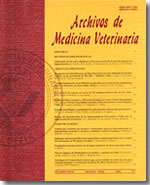Effects of selfing on the additive, environmental and phenotypic variation and on the heritability value for "shell length" in Argopecten purpuratus using an animal model
Main Article Content
Abstract
The northern scallop, Argopecten purpuratus, is a hermaphrodite species which has a great economic importance in Chile. Recently, hatchery techniques for juvenile production have been developed for this species, which allows the study the potential effects of selfing in the aquaculture of this species. In the present study we used selfing data obtained in an experiment to establish their effects on the heritability for shell length, by means of stochastic simulations of fullsib family data. Several families were produced using a factorial design (7x7), which allowed the statistical analyses of growth and survival of each family, with variable initial selfing percentage. PCR-based molecular markers (RAPD) developed in a previous study allowed the identification of selfing individuals within each family. The results indicate that heritability values were over-estimate in those families with high percentage of selfing. The selfing percentage was estimated at 6, 9 and 12 months of age, observing a significant reduction of it in each of the experimental families. The results obtained lead to conclude that even if the selfing has a negative effect on the development of the northern scallop, this happens only at individual level, affecting the fitness of the individuals which have been produced under that condition. However, those families produced by crossfertilization, which have variable selfing percentages among them, are not significantly affected, because this percentage is reduced gradually with the age of the individuals; therefore, by the time reproductors are selected in a genetic enhancement program, the effect of selfing will not be significant.

